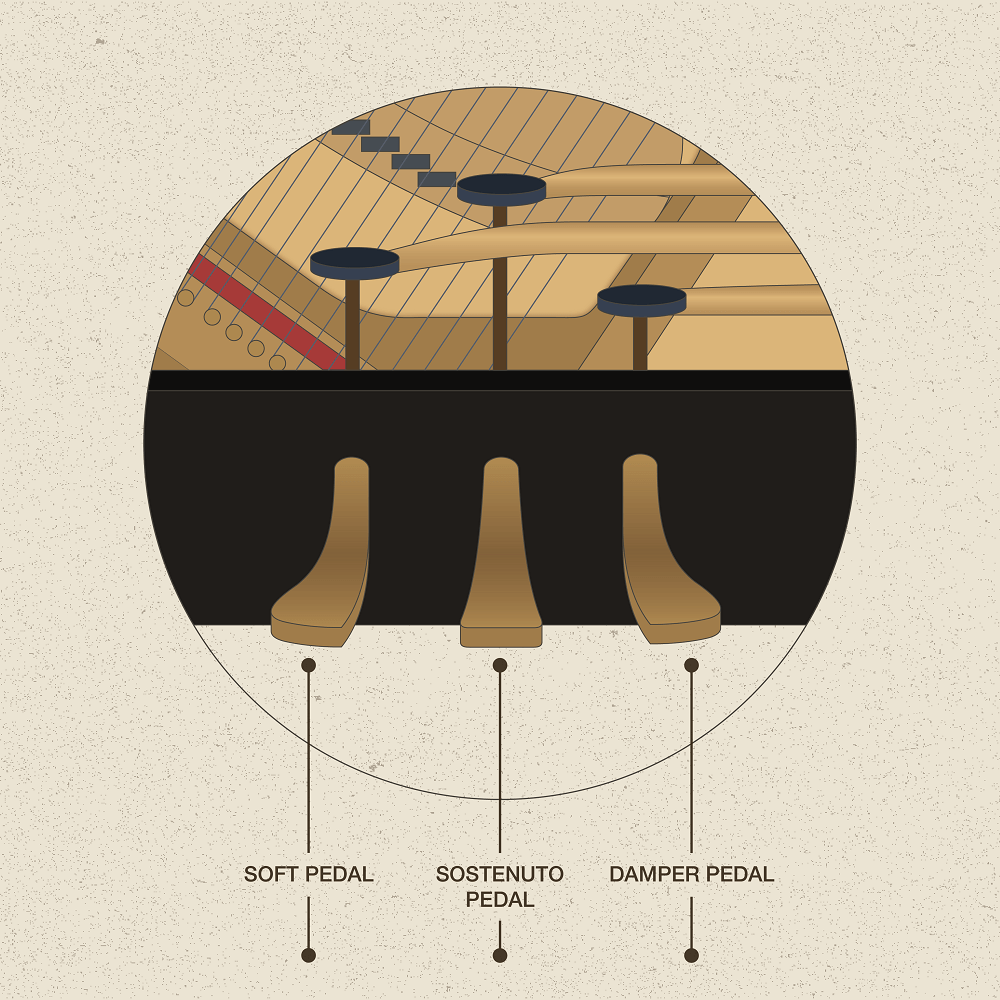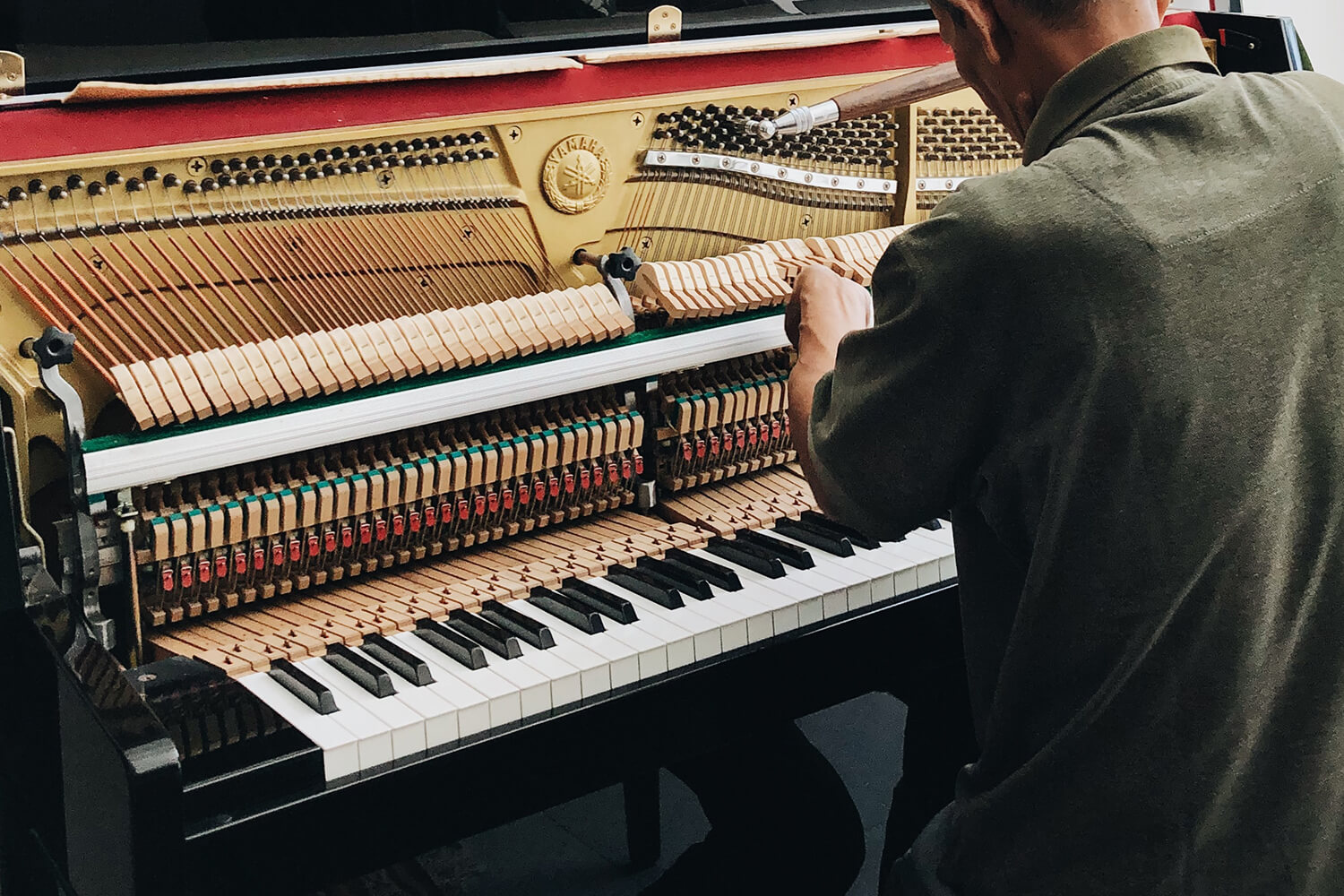For most instruments, it is fairly easy to see how they produce work. A bow is used to vibrate a string on a violin, a mallet strikes a drum, and blown air produces a flute’s tone. However, a piano can often seem mysterious since its many intricate, complicated parts are frequently hidden from our view. Discover how this fascinating instrument creates sound and learn how a piano works!
What Kind of Instrument are Pianos?
We can categorize instruments by their method of producing vibration. Typically, we divide instruments into four distinct categories:
- Brass
- Woodwinds
- Strings
- Percussion
So where does the piano fit into all of this? Interestingly, the piano is a bit of an oddball as it is considered both a percussion and string instrument. If we take a peek into the inner workings of a piano, we can observe that it consists of strings percussively struck by small hammers. How exactly does this entire mechanism work?
How Does a Piano Create Sound?
To begin understanding how a piano works, we should note that there are two main models of pianos – upright pianos and grand pianos. Uprights are generally compact and box-shaped with sound that projects from the rear panel. Grand pianos have a distinct, elongated shape with sound projecting upwards from a lid capable of opening and closing. The physical mechanics for producing sound are similar for both models, but have several distinct differences. Let’s begin with examining the upright piano.
How an Upright Piano Works
To answer the question “How does a piano work?” we focus on the upright piano first. The long strings of an upright piano are stretched by cross-stringing across a layered metal, V-shaped frame. These strings are held taut with tuning pins. Long, thick strings produce low pitches and short, thin strings produce high pitches. The tuning pins are attached to a sturdy framework known as a pin block that holds these pins in place. The soundboard, a large wooden panel behind the strings, amplifies the sound.
Take a look at the graphic below:

On a typical piano, we have 88 keys. Each singular key is part of a long lever that is hidden inside the piano. This lever is capable of moving up and down, a bit like a seesaw. When we press a key down, we are actually pressing down the entire lever. Pressing this lever down initiates a chain reaction that results in a felt hammer striking the string.
The Mechanics Behind Piano Keys
To begin this chain reaction, we will start by observing the wippen, attached atop the key lever. Another smaller lever, called the jack, is attached to the right side of the wippen. The jack is held in place and intercrossed by an additional lever and supporting beams. The jack is the most instrumental in pushing a felt-covered hammer to strike the strings. In the middle and upper registers of the piano, each hammer strikes 3 strings at a time. The lower registers have 2 strings struck at once, eventually decreasing to a thick, singular string on the very last note. This entire process is known as the action of the piano.
The damper is positioned behind this entire mechanism, resting on the strings. When a key is pressed, the damper moves away from the string, allowing the string to freely vibrate. When the key is released, the damper returns to its original position, instantly stopping the sound.
Now let’s take a look at the function of the three pedals at the bottom of the upright piano:

Beginning from the left, we have a soft pedal, sostenuto pedal, and a damper pedal. In an upright, the soft pedal moves all the hammers closer to the strings, creating a muted sound that has a specific dynamic tone. The sostenuto pedal, or practice pedal, serves a similar function by triggering muffler felt to drop between the hammers and strings, reducing volume and allowing a pianist to practice quietly. Finally, the damper, also commonly referred to as the sustain pedal, lifts all the dampers so that the vibration of each struck string continues to ring out. This pedal is frequently used to create a smoother sound, create atmospheric dynamics, and hold notes that cannot physically be held down all at once. You will notice that the pedal rod connects the pedals to the dampers.
What’s the Difference With Grand Pianos?
We previously discovered how an upright piano creates sound. This process is similar on a grand piano, but has a few notable differences. First, a grand’s strings are arranged horizontally on a sturdy frame with the soundboard underneath. If we lift up the lid on a grand, we can clearly see that the strings are longer for the low notes on the left side of the piano and shorter for the higher register on the right side. This arrangement gives the grand piano its unique shape. Since a grand is not designed to conserve space like an upright, the strings are longer, enabling the player to attain a wider dynamic range.
Secondly, since the strings and tuning pins are placed horizontally, the hammers are positioned underneath to strike upwards, allowing the hammer to utilize gravity to return to its natural position when released. Because of the vertical mounting of the pins in an upright piano, built-in springs must be used to ensure the hammers bounce back into their original position.
Finally, the function and mechanism of the sostenuto pedal is different on a grand piano. When a grand’s sostenuto pedal is pressed, only the selected notes a pianist is currently holding down will remain sustained.
Pianos are Amazing!
It’s truly fascinating to observe all the inner workings of the piano. Each part has a specific job that combines to create a beautiful, effortless sound. Next time you listen to piano music, take a moment to appreciate the amazing craftsmanship of this instrument! Learn more on how to clean your piano without damaging it!



